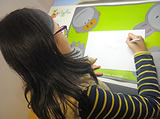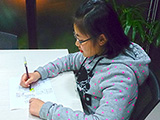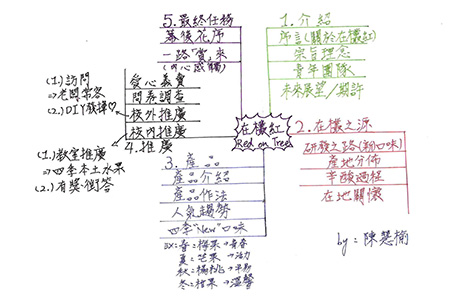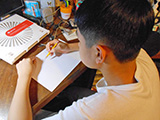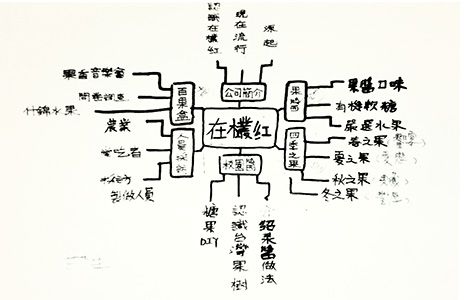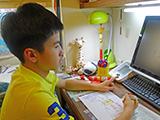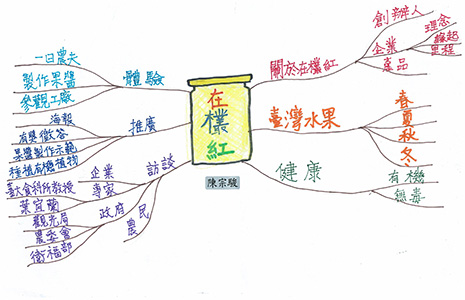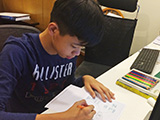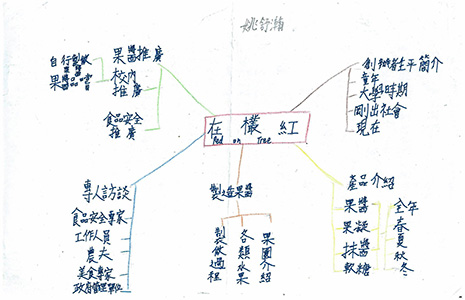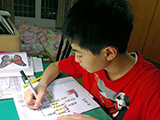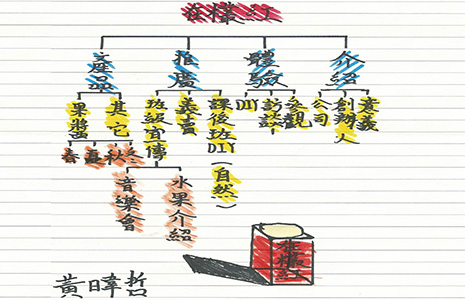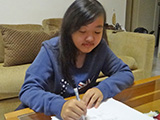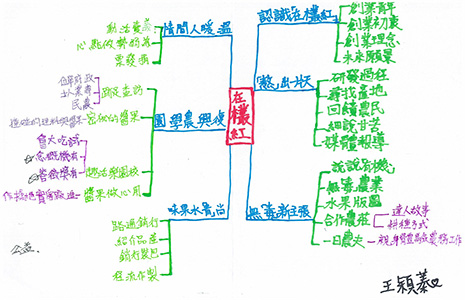From visiting Red on Tree, creating the Mind map, visiting orchards, selling natural jams and fruits in the school fair, to interviewing officials, scholars and farmers, we have enriched our research content.
Besides regular meetings, our teachers also mentored us during lunch breaks and after school, so as to help us improving our web design skills. Thanks to teachers’ guidance, we have polished our techniques in due time.
Lastly, we chose the song “Good to be a Farmer” which was about the early agricultural development in Taiwan to represent our project. We put forth our efforts in editing the music, and sang for recording. Hopefully, this Cyberfair project can help to promote local agriculture and local agricultural products.

| |
|
|
|
|
I deliberated on the categorization of webpage contents when I searched for information regarding Red on Tree. Then it occurred to me that I should create a mind map so that the website structure can be clearly presented. So I divided the contents into eight categories: Company introduction, Founder, Products, Apprentice, Promotion, Interviews, Questionnaire Survey, and Feedback.
For everyone to know more about Red on Tree, I provided more details in several sections. I also thought about some promotional activities, such as donating receipts for natural fruit drops by Red on Tree. I also thought about holding “food safety” seminars for people to learn about quality of handmade jams. We could also take a trip to visit the factory of Red on Tree and learn to make jam, so that our explanation on jam making would be more convincing. Then we could also interview some experts on food safety. This mind map can guide us to complete our webpage. |
|
|
| |
|
|

| |
|
|
After searching for information about Red on Tree online, I decided to categorize the contents into five sections for the mind map: Introduction, R&D, Products, Promotion, and Feedback.
The first part introduces the company structure, philosophy and future vision of Red on Tree. The second part discusses the R&D efforts of the company, including how to develop a variety of new flavors that might attract the consumers. We should also learn about the distribution of orchards that supply organic or toxin-free fruits to Red on Tree, and visit those orchards. The third part deals with the products of Red on Tree using in-season fruits and market promotion. The fourth part covers school promotion on food safety, and activities of charity sale and questionnaire survey, which intend to promote the products made with toxin-free fruits.
The final part reviews the activities, including orchard visits, charity sale, and jam making. I must say that I have earned valuable memories and knowledge during the course of the project. |
|
|
| |
|
| |
|
|

| |
|
|
|
|
Mind map is a good way to sort out ideas and delve into all respects of the theme. At first, I did not have the slightest idea about this project. Thanks to Teacher Lin’s introduction and web searches, I cleared out my thoughts and created a Mind map with concise wording for future exploration.
Aside from an introduction to Red on Tree, including its founding, jam making and its sales channels, I also hoped to visit the orchards, and see the cultivation and marketing processes. I also stressed food safety in the hope that visitors of our webpage might have a wider understanding of Red on Tree.
A systemic mind map could help us to have a comprehensive perspective of Red on Tree’s mission and operation. Hopefully this project could present the local business from a new angle. |
|
|
| |
|
|

| |
|
|
This is the second time for me to use mind-mapping skills to design webpage structure. I hope that I could grasp a clear direction for the webpage design this time.
When I first heard about Red on Tree, I learned that its products all are from local ingredients, so I decided the first part is to introduce the business vision of the founder. The second part describes the works and efforts of the farmers, as well as our experience in jam-making. The third part presents our efforts in school promotion, as well as the results of our interviews and questionnaire survey. The final part is our afterthoughts. I think these parts can constitute the complete webpage framework of our project.
Mind-mapping is indeed a useful visual tool for me to delineate the webpage structure. I believe that there will be ample opportunities for me to employ mind-mapping in other areas of learning. |
|
|
| |
|
| |
|
|

| |
|
|
|
|
As a consumer of Red on Tree, I was really glad to have this opportunity to have Red on Tree as our project theme. I divided the project into five sections as follows: Founding, Products, Interviews, Promotional Activities, and Experiences.
The first part is about the launch of Red on Tree. I wanted to have an interview with the founder and learn about his stories. I know the brand spirit of Red on Tree is: good origin, professional farmers, technology, and good products. I would like to discover the secret to accomplish those aspects. The second part introduces the product lines. All products used for making jams are locally grown and are toxin-free, in-season fruits. The third part is about the interviews with experts and farmers. I hoped that we could visit the orchards, talk to the farmers, and interview the professors and governmental officials. The fourth part is about promotional activities. We could promote food safety in school, where we share the knowledge of organic food vs. toxin-free food, as well as food safety certification labels. The fifth part is our hand-on experiences. We could visit the factory of Red on Tree, learn how to make jams. It would be best to pay a visit to institutes and know about the procedures of food inspection.
It is hoped that our project could allow the public to know more about Red on Tree, come to cherish the local produces, and know how to choose safe food. |
|
|
| |
|
|

| |
|
|
When I created the mind map, I came up with four key dimensions: (1) Introduction; (2) Experience; (3) Promotion; (4) Products. The first dimension involves the origin of the business and the core concepts of the founder. The second dimension refers to our feedback after a round of visits, interviews, and DIY experiences.
As to promotion, we could design a DIY jam-making program for the after-school class or hold a charity sale in the school fair, which could promote the products and help the farmers. We could also promote the food safety concepts on campus, so that the students can learn to choose healthy foods.
I also found that many of the team members know how to play musical instruments, so we could hold a concert to attract the attention from teachers and students, so that we could promote food safety. Since Red on Tree uses in-season fruits to make their products, we could introduce their products by season. For each season, there are introductions about the in-season fruits and related products. This mind map can provide a direction for the promotional activities. |
|
|
| |
|
| |
|
|

| |
|
|
|
|
After several sessions on essay writing, we began to make our mind maps, which could help us to think over, analyze, plan, sort, and organize the information.
Since deciding on the theme of our webpage, we began to categorize the content and made further searches over the subject. We discussed what kind of activities or interviews would be following. As our teacher taught us how to create a mind map, I thought about the core value of this project and the possible expanding directions. I used text and colors to express the ideas behind them, such as motivations, activity promotion, interviewee selection, and other activity experiences.
I designed a unique mind map with color indications. The rich contents are clearly presented. |
|
|
|






